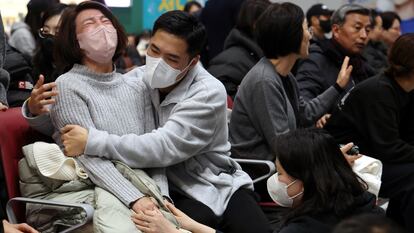Victims’ families and experts demand answers over South Korea plane crash
The Seoul government is resisting calls to answer whether the deadliest accident in the country’s history, which claimed 179 lives, was solely caused by a bird strike
The reasons behind the crash of the South Korean airline Jeju Air on Sunday, which resulted in the deaths of 179 out of 181 people on board, are sparking intense controversy. This tragedy, the deadliest air disaster in South Korea’s history, has left the victims’ families and much of the public demanding clear answers. Some aviation experts are questioning whether a bird strike, initially cited as the primary cause, could alone account for a crash of such magnitude. International analysts are urging the government to avoid making definitive statements before the investigation is complete. This accident is also the deadliest aviation disaster worldwide in 2024.
For now, South Korea’s Ministry of Land, Infrastructure, and Transport has avoided specifying the exact cause of the accident, stating that the investigation is ongoing. The ministry said that the priority is recovering the victims’ remains before beginning the analysis of the plane’s black boxes, which are crucial for understanding the incident. These devices record both flight data and cockpit conversations, providing vital information for reconstructing what happened.
Initial investigations suggest that the plane’s landing gear malfunctioned, leading to an emergency descent. This was followed by the plane skidding down the runway at high speed with the fuselage in direct contact with the asphalt, and unable to deploy the landing gear, as seen in videos released shortly after the accident.
According to sources at Muan International Airport in South Jeolla Province (southwest of South Korea), Flight 7C2216 from Bangkok was scheduled to land at 8:30 a.m. local time (00:30 CET). The twin-engine Boeing 737-800 was forced to abort its first landing attempt due to a landing gear issue, which was later linked to a bird strike, which the airport control tower warned of at 8:57 a.m., according to the Ministry of Transport.
South Korean media have shared a text message from a passenger to a loved one, in which they mention that a bird struck one of the wings, where the engines are located, and the passenger wondered if they should say their “last words.” At 8:58 a.m, the pilot requested help and attempted to land at 9:00 a.m., but the plane crashed three minutes later while trying to land without deploying the landing gear.
“I’ve never seen a bird strike prevent the landing gear from being extended,” Geoffrey Dell, an Australian aviation safety expert, told Reuters. While a bird strike could, in theory, damage the plane’s CFM International engines if the bird was sucked into a flock, Dell believes that even in such a scenario, the engines would not shut down immediately, giving the pilots enough time to manage the situation.
Witnesses on the ground told South Korean media that they saw flames coming from one of the engines and heard explosions before the plane attempted its emergency landing. These accounts, along with the sequence of events, suggest that although a bird strike may have occurred, it is unlikely to be the sole, or even the primary, cause of the crash. It is also unclear why the plane failed to brake after touching down.
One video shows the plane skidding off the runway, crashing into concrete structures marking the airport perimeter, causing it to explode and burst into flames. Geoffrey Thomas, editor of Airline News, questioned why emergency services were not on-site in time for the crash landing. In a typical belly landing, Thomas told Reuters, “you are going to land on your engines and you’re going to have a bumpy ride. You come in with minimum fuel, you have fire tenders in attendance, covering the runway with foam, and you land at the furthest end of the runway and usually it ends up being an OK situation.”
The issue of the runway’s length has also been raised. Vice Transport Minister Ju Jong-wan dismissed speculation that the relatively short runway was a contributing factor to the tragedy. “The runway is 2,800 meters long and has been used by C-type airplanes [with wingspans of 24 to 36 meters]. It would be safe to assume that the length of the runway is not why the accident occurred,” said Jong-wan. The plane that crashed had a wingspan of 35.8 meters. “Both ends of the runway have safety zones with green buffer areas before reaching the outer wall. The airport is designed according to standard aviation safety guidelines, even if the wall may appear closer than it actually is,” he added.
Transport authorities reported that the flight data recorder was found about two and a half hours after the accident, at 11:30 a.m. local time, while the cockpit voice recorder was recovered at 2:24 p.m. The data from these devices will provide critical insight into what happened during the flight. Experts caution that air accidents often result from a combination of factors, and it could take months to fully reconstruct the events, both inside and outside the plane.
Jeju Air has refrained from commenting on the cause of the crash during recent press conferences, citing the ongoing investigation. In line with international aviation protocols, South Korea will lead a civil investigation, which will automatically involve the U.S. National Transportation Safety Board (NTSB) since the Boeing 737 is designed and made in the United States. The Boeing 737-800 model involved in the crash is one of the most widely used aircraft in the world and has a generally good safety record, having been developed long before the Max variant, which was at the center of Boeing’s recent crisis due to malfunctioning issues.
Sign up for our weekly newsletter to get more English-language news coverage from EL PAÍS USA Edition
Tu suscripción se está usando en otro dispositivo
¿Quieres añadir otro usuario a tu suscripción?
Si continúas leyendo en este dispositivo, no se podrá leer en el otro.
FlechaTu suscripción se está usando en otro dispositivo y solo puedes acceder a EL PAÍS desde un dispositivo a la vez.
Si quieres compartir tu cuenta, cambia tu suscripción a la modalidad Premium, así podrás añadir otro usuario. Cada uno accederá con su propia cuenta de email, lo que os permitirá personalizar vuestra experiencia en EL PAÍS.
¿Tienes una suscripción de empresa? Accede aquí para contratar más cuentas.
En el caso de no saber quién está usando tu cuenta, te recomendamos cambiar tu contraseña aquí.
Si decides continuar compartiendo tu cuenta, este mensaje se mostrará en tu dispositivo y en el de la otra persona que está usando tu cuenta de forma indefinida, afectando a tu experiencia de lectura. Puedes consultar aquí los términos y condiciones de la suscripción digital.
More information
Archived In
Últimas noticias
Most viewed
- Reinhard Genzel, Nobel laureate in physics: ‘One-minute videos will never give you the truth’
- Oona Chaplin: ‘I told James Cameron that I was living in a treehouse and starting a permaculture project with a friend’
- Pablo Escobar’s hippos: A serious environmental problem, 40 years on
- Why we lost the habit of sleeping in two segments and how that changed our sense of time
- Chevy Chase, the beloved comedian who was a monster off camera: ‘Not everyone hated him, just the people who’ve worked with him’












































